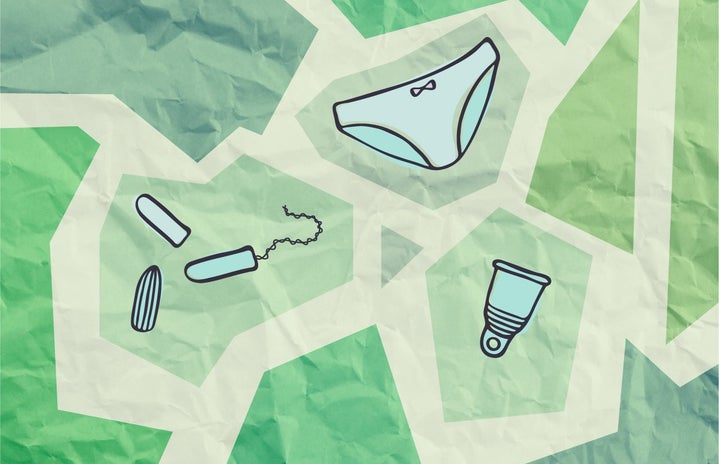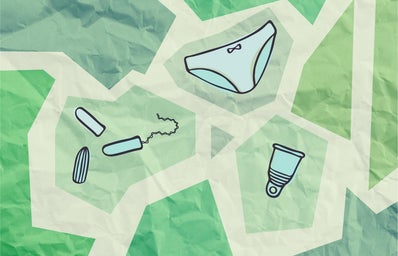Getting your monthly visit may have you believing that dealing with your period has very limited options. During middle school sex education classes and that awkward talk your parents gave you as a kid, you’re typically taught there are only two solutions to absorb the flow down there while you’re menstruating: pads or tampons. While both do the job, they come with a few cons. Pads can be clunky, while not every person is comfortable with inserting a tampon. Plus, ever heard of Toxic Shock Syndrome? Frankyl, I’m still scarred from my American Girl The Care & Keeping of You book.
Though pads and tampons are the most commonly used methods to help you deal with your period, many brands aren’t environmentally friendly at all. According to Bustle, approximately 20 billion used menstrual products are found annually in landfills just in North America. Not only do these non-biodegradable products clog our landfills, but they’re also incredibly toxic for our bodies. In some cases, the cotton used for pads and tampons are sprayed with pesticides and insecticides, which further contributes to the pollution of our water systems. Additionally, according to Organicup, pads are around 90% plastic, and when period products are disposed of in landfills, the earth “soaks up” their harmful chemicals, causing further pollution. On average, you’ll be using around 10,000 pads or tampons in your lifetime—that’s 10,000 used menstrual products polluting the earth from one person alone.
So if you’re someone that regularly has a period, you can control your impact on the environment. In the era of a potential Green New Deal and the growing problem of climate change, we can all do our part by making even the smallest of changes to our monthly routine!
Not only will these solutions below positively impact the environment, but they will also make your time of the month more comfortable for you and your body.
If you want to take baby steps
Organic pads and tampons
If you’re looking to make the simplest of switches to help out the environment, try exploring organic pads and tampons. These products are still disposable like your regular pads and tampons, but they are made without dangerous pesticides or chemicals that could potentially harm your body and the earth. Additionally, most organic menstrual products are plastic-free – another win for the environment!
If you want to help the environment in a small but impactful way, one company committed to organic menstrual products is Natracare. Natracare prioritizes creating products that are completely natural and free from fragrances, chlorine, and plastic, avoiding pollutants that can irritate your bits and harm the environment. Adjusting to organic products will be the easiest transition as they feel the most similar to pads and tampons. Additionally, you can also get organic pads and tampons through notable stores such as Target and Amazon. London Green, a freshman at the North Carolina A&T State University, noted that there were a few pluses and drawbacks to the organic period product craze.
“Once I tried them, I noticed that I did not cramp as often as usual, [and] it was very surprising. However, because my flow is extremely heavy, they do not work out well for me. It seems they don’t have much absorption and they become uncomfortable,” London says. “I will only use them when my period is beginning to slow down.” If you have a lighter period, organic pads and tampons may be your best bet—but if you have a heavier flow, you might want to save this for your menstrual cycle’s last days.
Period panties
If you are one of those people who doesn’t even want to worry about your period, then period panties may be a worthy investment. These reusable underwear are meant to last well into the day, and most of them can hold up to two tampons worth of blood before needing to be removed. Notable companies such as Thinx and Lunapads stress that you can wear these pads for almost a whole day, and if you have a particularly heavy flow, switch out the inserts so you don’t have to change your underwear.
If you’re wondering how exactly period panties are environmentally friendly, they are usually made with organic materials and are completely washable. According to Bustle journalist Gabrielle Moss, her period panties have lasted well into their second year. While it may be a pricey initial purchase (retailing at $35), the long-lasting guarantee ultimately makes period panties a cheaper option than repeatedly buying disposable pads or tampons.
Related: We Asked How You Guys Deal With Period Stains & Learned So Many Bloody Period Secrets
If you’re eco-friendly, but also prioritize comfort
Reusable pads and tampons
Say what now? If you’re wondering how exactly pads and tampons could be reusable, you’re not alone. However, if you do your research, there are many companies dedicated to transforming typical single-use products into longer-lasting investments. For example, Gladrags offers reusable pads that come with two inserts that you can adjust based on how much absorbency you will need that day. Not only can you wash these, but you can also pick fun little designs, so you feel cuter throughout the blah days of your period.
As for reusable tampons, these are not mass-made, so you can make them at home or buy some off of Etsy. You can crochet them or make them with an absorbent material that is more comfortable than regular tampons (according to Bustle, some good ideas are bamboo and hemp). Make sure you have a few at a time, though—you have to soak and wash your reusable tampons to ensure their cleanliness for their next use.
Cloth pads
Cloth pads are a comfortable reusable pad option that will last you throughout your period and beyond – plus, they are soft and super comfortable, keeping your downstairs area happy during a time when irritation is common. As referenced above, companies such as Gladrags make cloth pad sets – again, priced at $150, these cloth pads are meant to last you years while remaining good for the environment. Additionally, this set comes with a separate laundry set in order for you to wash these pads.
According to journalist Victorine Lamothe, however, cloth pads are not without their cons as well. Despite being better for the environment and keeping you comfortable throughout your menstrual cycle, it can be an inconvenience to your busy schedule to repeatedly soak, wash, dry, repeat every single pad as your period progresses. You also may not want to carry around a soiled pad throughout the day.
University of North Carolina Charlotte senior Hannah Luke uses menstrual cups, and said that even though she was dedicated to becoming as eco-friendly as possible, she didn’t necessarily want to try cloth pads or period underwear as she viewed the consistent washing as a “nightmare” and believed she would be consistently worried about the effectiveness of the underwear.
However, these cloth pads are still a solid, reusable option for those looking to go a more comfortable green!
Related: To End My Period Cramps, I Tried a Surprisingly Cute ‘Off-Switch for Period Pain’
If you want to really commit
Sea sponge tampons
You may have had the same reaction that I did when you read “sea sponge tampons” – which are, contrary to my initial thought, completely real and safe alternatives to using disposable tampons. Though I literally thought I was getting pranked reading that phrase, sea sponge tampons are a growing environmentally friendly option for those who don’t want to use regular tampons.
Sea sponge tampons are reusable and biodegradable, and since they’re completely natural, you won’t be harming the earth when you purchase these funky sponges. Sea sponge tampons are reusable and biodegradable, and since they’re completely natural, you won’t be harming the earth when you purchase these funky sponges. The sea sponges are absorbent and soft, however, there is one drawback.
According to Bustle, you have to consistently take out the sponge once every three hours to rinse and re-insert, which is a relatively short time frame. If you are simply seeking comfort, and don’t mind the consistent removal, sea sponge tampons could be a new period product to add to your collection. If you’re interested in trying out a sea sponge, you can purchase them at Amazon and Honest Beauty.
Menstrual cups
In one of the most popular trends regarding environmentally-friendly period care, menstrual cups promise to replace tampons and pads with a cup that catches your menstrual blood and can be worn for up to 12 hours. The menstrual cup is among one of the most environmentally friendly products on this list—it can last for up to a decade! Menstrual cups are also fairly easy to use: insert, take out (after 12 hours), dump the blood, rinse, and repeat. Organicup did a study approximating how much you would save by switching to menstrual cups—in 10 years, you would use an average of 2,640 pads and tampons. With the menstrual cup, you reduce that product footprint to one.
Boston University senior Zoe Hawryluk expressed both the financial and environmental benefits of menstrual cups, saying, “I haven’t bought tampons in three years, which is amazing for my wallet when they can cost up to $20 to $25 for a big box of them. I feel like I’m taking better care of my body while also taking care of the planet.”
Additionally, Zoe explained that menstrual cups have health benefits as well. “There is no risk for Toxic Shock Syndrome with Diva Cups, which is a huge bonus. They keep you smelling nice down there, because they’re air locked when you insert them correctly. It also helps me monitor my flow so I know if something about my cycle is weird, off, or if I’m bleeding too much.”
However, the menstrual cup can be intimidating—how are you meant to shove a cup up there?! Don’t worry, companies such as Diva Cup have tutorials on their website so you’re not completely lost. If you need to take it easy, just use any of the alternatives listed above rather than going straight for a menstrual cup. And don’t panic if it feels a little unfamiliar at first—North Carolina A&T State University junior Jasmine Hunter says that when she first went to remove the menstrual cup, it was stuck. Though she hit this snafu, Jasmine says that once she relaxed, she was able to retrieve the menstrual cup. If your first time inserting and removing a menstrual cup doesn’t go smoothly, evaluate after whether a menstrual cup is something you’d be willing to work at or whether you just want to stick to more eco-friendly pads and tampons.
Any little action can help make the environment a better place—and where better to start than with ourselves? Make your monthly visit from Mother Nature positive for the planet, not negative. Any of these listed products will guarantee a safer, happier Planet Earth! Maybe you won’t dread your time of the month when you know you’re helping a good cause.


